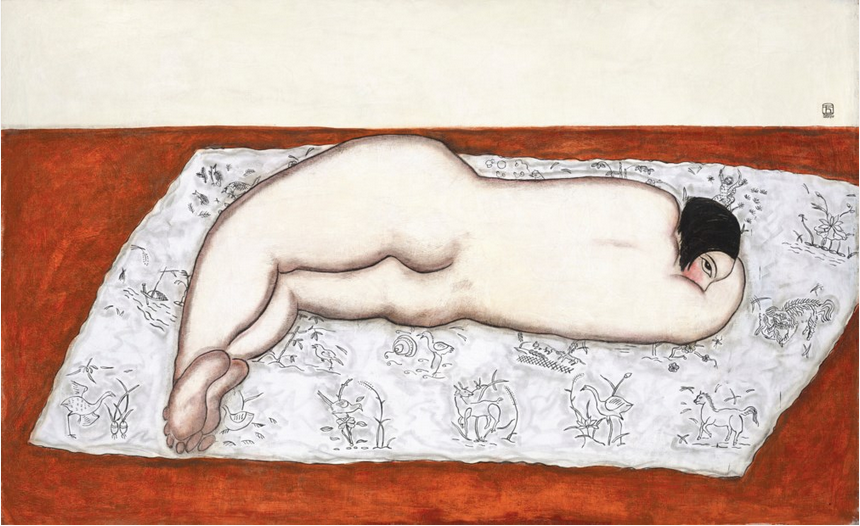Works by Sanyu in upcoming Hong Kong sales
[28 Nov 2023]Christie’s Hong Kong is preparing its last major Hong Kong sales of the year at the city’s Convention and Exhibition Centre after roadshowing the works on offer throughout the region. In the evening of 28 November, the series of sales will conclude with a session reserved for 20th and 21st Century Art, with – as its centerpiece – the first large nude ever painted by San Yu, Nude on Tapestry, a highly coveted masterpiece that has never been shown in Asia before.
From the prestigious Dreyfus collection, Nude on Tapestry is a work painted in 1929, measuring 81 by 130 cm, presented in the catalog as being from “The golden era of East-meets-West”. This pioneering work fuses a Western subject (the nude, in this case the artist’s muse, Kiki de Montparnasse) with a typically Eastern technique via the sharp and fluid lines inherited from Chinese calligraphy. This combination is likely to appeal to both Western and Chinese collectors.

Sanyu, Nude on Tapestry, 1929
In addition, the painting dates from a key period in the artist’s life and career because in 1929 Sanyu was introduced to the collector and art dealer Pierre-Henri Roché, whose enormous support would propel his career towards new heights. That same year, he also met his future wife, Madame Hardrouyère. The work is also relatively rare since of the fifty-six female nudes Sanyu painted (in a total oeuvre of some three hundred oil paintings) this early canvas is one of only five depicting the back of a female figure.
Another particularity of this canvas lies in the treatment of space and the motifs of the tapestry which are clearly depicted and which fill the work with a series of auspicious Chinese symbols and enigmas. The Chinese character for a deer is 鹿, pronounced “lù” which can also mean social status; the crane is a rebus for continued success; the Chinese rose is a symbol of longevity. The fight between a snipe and a clam comes from popular folklore. These pictorial puns are deeply rooted in traditional Chinese culture and they add an extra layer of meaning to the canvas.
The painting is expected to fetch one of Sanyu’s ten top auction results
Given its multiple qualities and Christie’s estimate of $12.8 – 19 million, the painting could fetch one of Sanyu’s top-10 auction results. It may also generate one of Hong Kong’s Top 3 results this year.
For several years now, Hong Kong has stolen the limelight from Paris when it comes to the sale of Sanyu’s most important paintings. In 2019, Christie’s hammered the artist’s personal record of $38.8 million for Five nudes. But in view of the high estimate provided at the time ($70 million) by the auction house, it is clear that Sanyu is expected to double this peak in the future. Art market specialists are banking heavily on a growth in prestige of the artist, and academic research is continually underscoring Sanyu’s unique place in the history of modern art.
Sanyu’s turnover at auction by country (copyright Artprice.com)

Sanyu, a bohemian lifestyle
Initially schooled at home in Sichuan, China, Sanyu took calligraphy lessons with Zhao Xi (1866-1948) and painting lessons with his father, an animal painter, before training at Shanghai University. When he settled in Montparnasse in 1921, the Paris of that time was, for Sanyu, a promised land where both the masterpieces of art history (in museums and galleries) rubbed shoulders with all the promises of the avant-garde. He began by attending the relatively liberal Grande Chaumière to study life drawing, particularly the nude, a major subject in the history of Western art.
It didn’t take long for Sanyu to be assimilated into artistic communities. He became friends with Alberto Giacometti at the Grande Chaumière, and his fellow Chinese artist, Pang Xunqin, remembers that Picasso painted Sanyu’s portrait. In 1929, Henri-Pierre Roché, who had already supported the careers of Duchamp, Braque and Brancusi, agreed to be his dealer. Despite this, Sanyu remained poor because he frequently refused requests to purchase his paintings and regularly ignored offers from other dealers.
In 1966, aged 64, he accidentally left the faucet of his gas stove open and died in his sleep. He was found with a book on his chest. The artist could have been forgotten altogether but fortunately, his work was rediscovered by Taiwanese art dealers following the China-Paris exhibition of 1988 at the Taipei Museum of Fine Arts. This was followed by a solo exhibition at the Guimet Museum, Sanyu, Body Language, and another at the Cernuschi Museum, (The Legacy of 20th Century Chinese Masters).




 0
0
